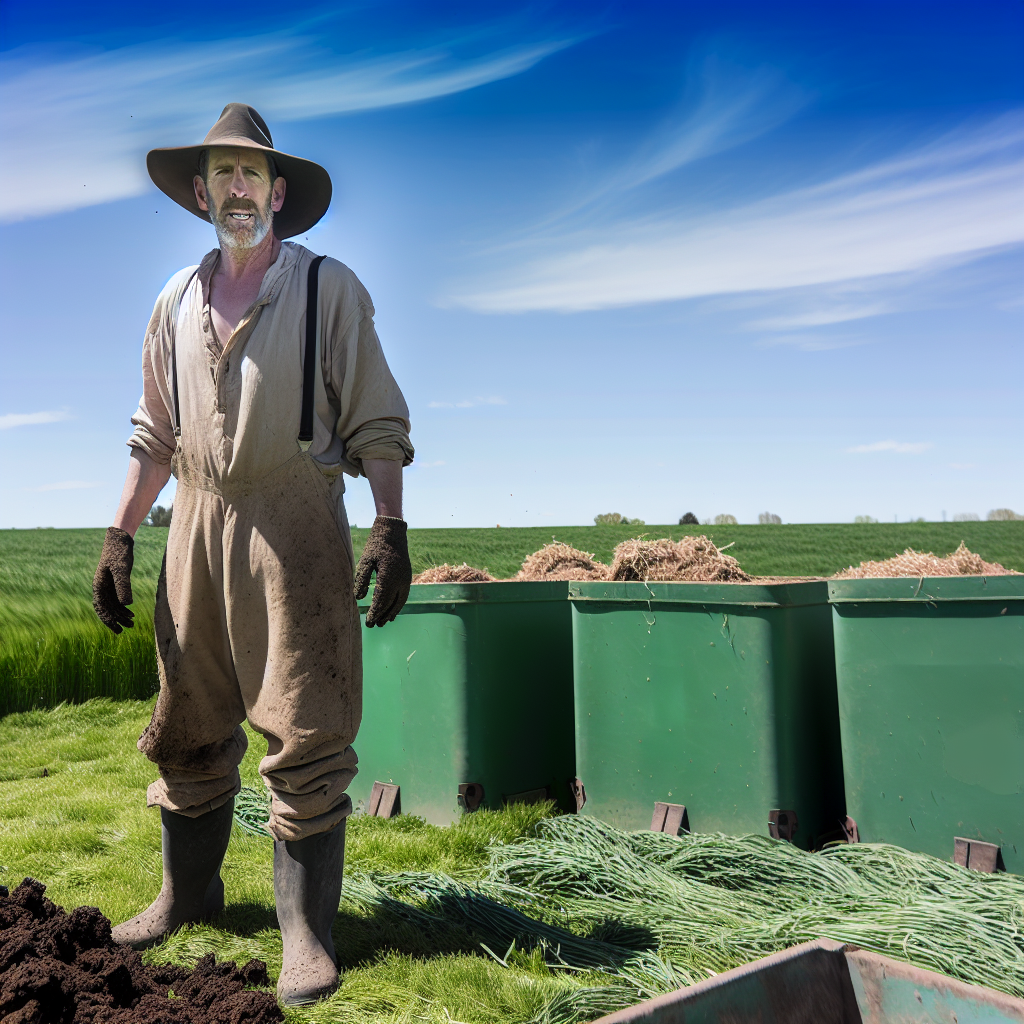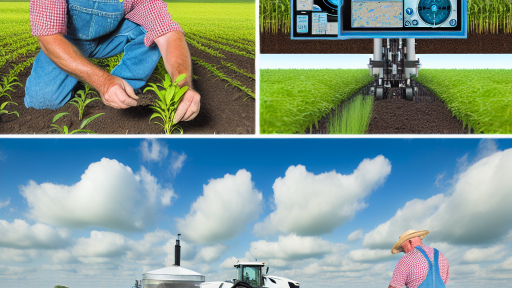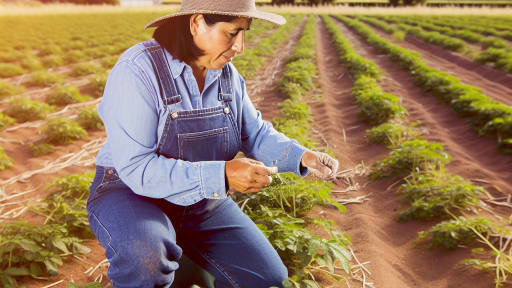Introduction to Carbon Sequestration
Carbon sequestration refers to capturing atmospheric carbon dioxide.
It plays a critical role in mitigating climate change.
This process involves various natural and artificial methods.
Specifically, it is essential for sustainable agriculture.
Defining Carbon Sequestration
It primarily involves the storage of carbon in soil and vegetation.
Farmers can enhance carbon storage through diverse practices.
Techniques include agroforestry and no-till farming.
Additionally, cover cropping improves soil health and captures carbon.
Significance for Sustainable Agriculture
Sustainable agriculture focuses on long-term productivity.
Carbon sequestration enhances soil fertility and biodiversity.
It also contributes to reducing greenhouse gas emissions.
Moreover, capturing carbon can lead to healthier ecosystems.
Impact on Climate Change
Climate change poses significant challenges to agricultural sectors.
By sequestering carbon, farms help lower atmospheric CO2 levels.
This action supports global efforts against climate change.
Transform Your Agribusiness
Unlock your farm's potential with expert advice tailored to your needs. Get actionable steps that drive real results.
Get StartedFurthermore, increased carbon storage strengthens farm resilience.
Sustainable Practices That Promote Sequestration
Farmers can adopt specific practices to aid carbon sequestration.
- Implement cover crops to enhance soil organic matter.
- Utilize reduced tillage techniques to minimize soil disturbance.
- Incorporate agroforestry systems to capture carbon in trees.
- Practice rotational grazing to improve land health.
- Apply organic amendments such as compost and manure.
Each of these methods can effectively sequester carbon.
Consequently, they create a more sustainable farming environment.
Overview of Carbon Sequestration Practices in Farming
Introduction to Carbon Sequestration
Carbon sequestration involves capturing and storing atmospheric carbon dioxide.
This process mitigates climate change by reducing greenhouse gases.
Farmers play a vital role in implementing these practices globally.
Types of Carbon Sequestration Practices
There are several effective carbon sequestration practices in agriculture.
These practices include cover cropping, agroforestry, and no-till farming.
Cover cropping improves soil health while capturing carbon.
Agroforestry integrates trees into farming systems, enhancing biodiversity.
No-till farming minimizes soil disturbance, promoting carbon storage.
Benefits of Carbon Sequestration for Farmers
Implementing these practices yields numerous benefits for farmers.
Soil quality improves, leading to better crop yields.
Farmers also experience reduced erosion and improved water retention.
Additionally, they contribute to climate change mitigation efforts.
Case Studies from Around the World
Several countries have successfully implemented carbon sequestration practices.
In Brazil, agroforestry systems have increased carbon storage significantly.
Farmers in the United States adopt cover cropping to enhance soil resilience.
These case studies highlight the effectiveness of diverse approaches.
Challenges Facing Implementation
Despite the benefits, challenges remain in adopting these practices.
Initial costs can deter farmers from making the switch.
Moreover, lack of knowledge about best practices limits adoption.
Farmers may also face resistance to changing traditional methods.
Showcase Your Farming Business
Publish your professional farming services profile on our blog for a one-time fee of $200 and reach a dedicated audience of farmers and agribusiness owners.
Publish Your ProfileThe Future of Carbon Sequestration in Farming
Innovations in technology will enhance carbon sequestration practices.
Research continues to develop new methods and improve existing ones.
Collaboration among farmers, researchers, and policymakers is essential.
Together, they can create systems that promote sustainability and resilience.
Cover Cropping: Techniques and Benefits for Enhancing Soil Carbon Storage
Introduction to Cover Cropping
Cover cropping is a vital practice in sustainable farming.
This technique involves growing specific plants between main crops.
Farmers use cover crops to improve soil health and carbon storage.
These crops play a crucial role in minimizing erosion.
Techniques for Effective Cover Cropping
Selecting the right species is essential for successful cover cropping.
Legumes are often favored for their nitrogen-fixing abilities.
Additionally, grasses can increase soil biomass effectively.
Farmers can plant cover crops in early spring or fall.
Timing is critical to maximize growth before main crops are established.
Planting Methods
There are several effective planting methods available.
Direct seeding allows for quick establishment of cover crops.
Additionally, broadcasting seeds ensures even coverage across fields.
Some farmers use intercropping to integrate cover crops with main crops.
Benefits of Cover Cropping
Cover crops offer numerous benefits for sustainable agriculture.
They significantly enhance soil carbon sequestration over time.
Moreover, cover crops improve overall soil structure.
They aid in moisture retention and nutrient cycling.
Weed and Pest Management
Cover crops also assist in managing weeds effectively.
They can reduce weed pressure by outcompeting unwanted plants.
This strategy minimizes the need for chemical herbicides.
Notably, certain cover crops can deter specific pests.
Case Studies and Successful Implementations
Farmers around the world have successfully implemented cover cropping.
For example, Sofia Reyes employs clover on her organic farm.
This practice improved her soil quality and reduced her fertilizer costs.
Additionally, farms in the Midwest report increased yields through this method.
Measuring Success
To evaluate the success of cover cropping, measure soil carbon levels.
Regular testing provides insights into effectiveness and improvements.
Farmers can also track changes in crop yields over seasons.
Documentation of practices helps in sharing knowledge within the farming community.
Gain More Insights: Sustainable Farming Practices Boosting Biodiversity
Agroforestry: Integrating Trees into Cropping Systems for Improved Carbon Sequestration
Overview of Agroforestry
Agroforestry combines agriculture and forestry practices.
This method enhances biodiversity and ecosystem health.
Farmers integrate trees and shrubs into cropping systems.
This strategy promotes carbon sequestration effectively.
Benefits of Agroforestry
Agroforestry offers several environmental benefits.
It improves soil health through enhanced organic matter.
Showcase Your Farming Business
Publish your professional farming services profile on our blog for a one-time fee of $200 and reach a dedicated audience of farmers and agribusiness owners.
Publish Your ProfileTrees reduce soil erosion by stabilizing the soil structure.
They increase water retention in the landscape.
Additionally, diversified plant growth supports wildlife habitats.
Carbon Sequestration Potential
Trees absorb carbon dioxide from the atmosphere.
They store carbon in both biomass and soil.
This process mitigates climate change effects significantly.
Implementing Agroforestry Practices
Farmers can adopt various agroforestry practices.
They might plant tree rows alongside crops.
Cover cropping can also improve soil health and biomass.
Another approach is silvopasture, integrating trees with livestock.
Choosing Appropriate Tree Species
Selecting the right tree species is critical.
Farmers should consider local climate and soil types.
Native species often provide the best results.
Examples include black walnut and eastern red cedar.
Challenges and Considerations
Despite the benefits, agroforestry faces challenges.
Initial setup costs can deter some farmers.
Additionally, understanding tree-crop interactions requires knowledge.
Farmers may also encounter regulatory hurdles.
Overcoming Challenges
Education on agroforestry practices is vital.
Extension services can provide valuable resources.
Networking with experienced agroforesters can offer support.
Long-term Impact of Agroforestry
Over time, agroforestry can transform farming landscapes.
It contributes to carbon neutrality in agriculture.
Consequently, it supports sustainable farming goals globally.
See Related Content: Choosing the Right IPM Tools for Your Farm
Conservation Tillage: Exploring Methods and Their Impact on Soil Health and Carbon Retention
Understanding Conservation Tillage
Conservation tillage involves minimizing soil disturbance during planting.
This method protects soil structure and health significantly.
Farmers can implement various practices to achieve conservation tillage.
These practices enhance carbon sequestration in agricultural systems.
Types of Conservation Tillage
There are several types of conservation tillage methods.
No-till farming is a popular technique.
In no-till systems, farmers plant directly into undisturbed soil.
Additionally, reduced-till practices involve minimal soil disruption.
These practices can vary in depth and frequency of tillage.
Benefits of Conservation Tillage
Conservation tillage offers numerous benefits to soil health.
It increases organic matter and improves soil structure.
Moreover, it enhances water retention capabilities of soils.
This method can significantly reduce erosion risk.
Consequently, farms using conservation tillage often show improved yields.
Impact on Carbon Retention
Conservation tillage plays a crucial role in carbon retention.
Showcase Your Farming Business
Publish your professional farming services profile on our blog for a one-time fee of $200 and reach a dedicated audience of farmers and agribusiness owners.
Publish Your ProfileThe reduced soil disturbance maintains soil carbon levels.
Farms that utilize conservation tillage can sequester more carbon.
In turn, this helps mitigate climate change effects.
Long-term studies indicate substantial carbon benefits over time.
Implementing Conservation Tillage
Farmers can adopt specific practices for successful implementation.
Monitoring soil health is essential for ongoing success.
Applying cover crops enhances the benefits of conservation tillage.
Additionally, crop rotation can improve overall soil resilience.
Education and training programs support farmers in these transitions.
Challenges and Considerations
Despite its benefits, challenges exist in adopting conservation tillage.
Initial investment costs may deter some farmers.
Additionally, some may fear lower yields during the transition period.
Customized strategies can help mitigate these concerns.
Continuous education can facilitate smoother transitions for farmers.
Find Out More: Carbon Sequestration Technologies for Modern Farms

Crop Rotation: How Diverse Planting Strategies Can Increase Soil Organic Matter and Carbon Levels
Understanding Crop Rotation
Crop rotation involves alternating the species of crops grown in a particular area over time.
This practice enhances soil fertility and helps prevent pest buildup.
Farmers can optimize their land’s productivity through diverse planting strategies.
Benefits of Diverse Planting Strategies
Diverse planting can significantly boost soil organic matter levels.
This increase in organic matter naturally enhances carbon sequestration.
For example, legumes fix nitrogen and enrich the soil, benefiting subsequent crops.
Moreover, rotating crops reduces soil erosion and improves water retention.
Implementing Effective Crop Rotation
Farmers need to plan their crop rotations carefully.
Choosing compatible crops ensures healthier soils and better yields.
For instance, following a cereal crop with a legume can balance nutrient levels.
Additionally, incorporating cover crops during fallow periods contributes to soil health.
Examples of Successful Crop Rotation Practices
- Rotating corn with soybeans can prevent nutrient depletion.
- Planting carrots followed by onions discourages pest populations.
- Utilizing clover as a cover crop can enhance soil structure.
Challenges and Solutions
One challenge in crop rotation is the need for advanced planning.
Farmers must monitor market demands for various crops.
Embracing technology, such as crop management software, can alleviate these issues.
Moreover, education on best practices will support farmers in transition.
Discover More: Biodiversity’s Impact on Sustainable Food Production
Soil Amendments: Utilizing Composts and Biochar to Boost Soil Carbon and Nutrient Availability
Benefits of Composts
Composts enrich soil by increasing organic matter content.
They improve soil structure, enhancing water retention.
Additionally, they promote microbial activity crucial for soil health.
Composts also provide essential nutrients for plant growth.
Farmers can easily create composts from organic waste materials.
Implementing Composting Practices
Start by collecting kitchen scraps and yard waste.
Ensure the compost pile has a balanced mix of greens and browns.
Regularly turn the compost to aerate and speed up decomposition.
Monitor moisture levels; keep the compost damp, not soggy.
Showcase Your Farming Business
Publish your professional farming services profile on our blog for a one-time fee of $200 and reach a dedicated audience of farmers and agribusiness owners.
Publish Your ProfileUtilize mature compost by spreading it across fields before planting.
Potential Challenges with Composts
Composting requires time and proper management to be effective.
Pests might be attracted if not managed correctly.
Additionally, an imbalanced compost can lead to nutrient deficiencies or toxic substances.
Farmers need to be educated on proper composting techniques.
Exploring Biochar
Biochar serves as a soil amendment with unique benefits.
It enhances nutrient retention and improves soil aeration.
Biochar can sequester carbon for long periods in the soil.
This minimizes greenhouse gas emissions in agricultural practices.
How to Use Biochar Effectively
Incorporate biochar into the soil before planting to improve soil structure.
Mix biochar with compost for a nutrient-rich amendment.
Consider specific crop needs when applying biochar rates.
Challenges with Biochar Adoption
Biochar production can be energy-intensive and require investment.
Farmers must understand the right biochar types for their soils.
Further research is still needed on optimal application methods.
Integrating Both Practices
Combining composts and biochar can maximize soil benefits.
This approach promotes healthy, carbon-rich soils.
Both methods can contribute to sustainable farm practices.
Farmers will find that integrated efforts yield improved productivity.
Measurement and Monitoring: Tools and Technologies for Assessing Carbon Sequestration in Agricultural Practices
Importance of Measurement and Monitoring
Measurement and monitoring play a crucial role in effective carbon sequestration.
They provide data that helps farmers make informed decisions.
Moreover, accurate assessments support sustainable farming practices.
Technologies for Carbon Sequestration Measurement
A variety of technologies exist for measuring carbon sequestration.
Soyl carbon sensors offer precise readings of carbon levels in the soil.
Remote sensing technology enables farmers to monitor large areas efficiently.
Satellite imagery assists in tracking changes over time.
Drone technology enhances monitoring by providing detailed field insights.
Soil Sampling Techniques
Soil sampling remains a foundational method for assessing carbon levels.
This technique involves collecting soil samples from various depths.
Farmers can analyze these samples in a lab for accurate data.
For best results, taking samples at different seasons is recommended.
Data Collection Methods
Effective data collection methods enhance the accuracy of assessments.
Field surveys can gather essential information on different farming practices.
Farm management software can streamline data input and analysis.
Utilizing Models and Simulations
Models and simulations predict the outcomes of different agricultural practices.
These tools allow farmers to assess the potential impact of their choices.
Furthermore, they can simulate various climate scenarios to predict changes.
Integrating Citizen Science
Citizen science initiatives can reinforce monitoring efforts.
Farmers and local communities can collect valuable data collaboratively.
This approach boosts community engagement and awareness regarding carbon practices.
Showcase Your Farming Business
Publish your professional farming services profile on our blog for a one-time fee of $200 and reach a dedicated audience of farmers and agribusiness owners.
Publish Your ProfileChallenges to Effective Measurement
Despite advances, challenges persist in measuring carbon sequestration.
Variability in soil types complicates consistent assessment methods.
Additionally, a lack of standardized practices can hinder data comparability.
Future Directions in Technology
The future of carbon measurement lies in integrating advanced technologies.
Artificial intelligence can enhance data analysis and predictions.
Blockchain technology may improve transparency in carbon credits.
Key Findings on Measurement and Monitoring
Effective measurement and monitoring are vital for sustainable farming.
Adopting diverse technologies can significantly enhance carbon capture efforts.
By addressing challenges, the agricultural sector can move toward sustainability.
Additional Resources
Soil Health and Carbon Sequestration in US Croplands: A Policy …
Carbon Sequestration Potential on Agricultural Lands: A Review of …




